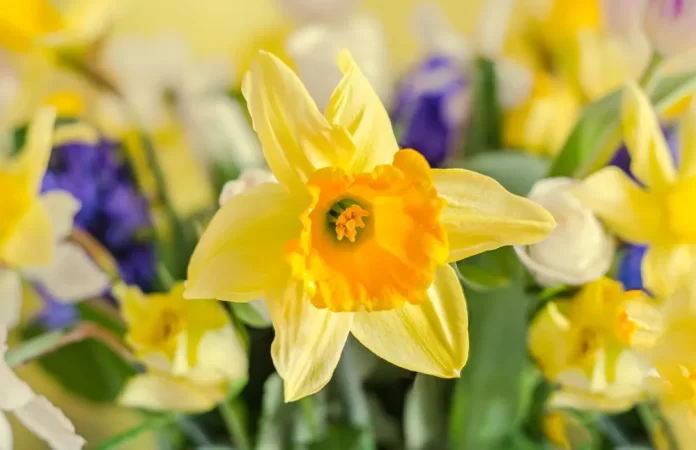The rose flower symbolizes Our Lady. Likewise, other saints have a flower that represents them. There are many reasons for ascribing flowers to the saints.
The month of May is one of the months dedicated to Our Lady, and it is also the month of roses, which witnesses their most luxuriant flowering.
But there are other flowers that have been associated, for different reasons, with Our Lady and other saints. There are many saints who are associated with flowers, and very often we see statues of those saints adorned with specific flowers.
The Lily, the Flower of Saint Catherine
Saint Catherine of Siena, Patroness of Italy, and Patroness of Europe, is pictured with a book, a symbol of the doctrine, the ring, which symbolizes the mystical wedding between her and Jesus, and a lily, a symbol of purity. In other representations, white flowers gush from her stigmata, while on her head is adorned with a crown of thorns.
Spikenard, the Flower of St. Joseph
The reason why the spikenard flower is associated with St. Joseph as he is the foster father of Jesus. It also appears in the coat of arms of Pope Francis. The association of Saint Joseph with the spikenard is typical of Hispanic San Giuseppe countries, where the saint is often depicted with a twig of spikenard in the hand. A fragrant oil of great value, since ancient times, is obtained from the spikenard and has been used as perfume: spikenard oil. St. Joseph is also often pictured with a stick from which lilies bloom, a symbol of the Virgin’s purity.
The Lily, the Flower of Saint Anthony
Saint Anthony of Padua is also often depicted with white lilies. According to his Sermons, represented penitents: “Consider that in the lily there are three properties: medicine, whiteness, and perfume. The drug is found in its root, the whiteness and scent in the flower. And these three properties represent the penitents, who are poor in spirit, who crucify their members with their vices and their lust, who guard their humility in the heart, the candor of chastity in the body and the perfume of good fame and suffocate the impudence of pride.”
The Hypericum, the Flower of St. John
Hypericum, or St. John‘s wort, is a herbaceous plant widespread throughout Italy. Since it blooms mainly between June and August it has been associated with the feast dedicated to St. John, which falls on 24 June. If the yellow flowers of the Hypericum are harvested tonight, they will have miraculous power both to fight disease and to drive away evil spirits. Today, hypericum is used in herbal medicine to treat depression, anxiety and fatigue.
All the flowers of Saint Teresa
Sieboldii Sedum is known as St. Teresa’s Grass or “Teresina”. It blooms in October, the month dedicated to Saint Teresa of the Child Jesus (Teresa of Lisieux) and Saint Teresa of Avila. Native to Japan, it is a fatty plant that does not require great care.
But Saint Teresa of Lisieux is also associated with roses and pratinas. Particularly in these last, humble and delicate flowers, she recognized herself very much, as we read in her memoirs: “As the sun illuminates at the same time the cedars and every flower as if this were only on earth, so Our Lord cares individually for each soul… so that the humblest pratina blossoms in the established time” (History of a Soul).
At the point of death, St. Teresa announced: “You will see at the moment of my death that cascade of roses I will rain on the earth.” For this reason, in the iconography the Saint is often represented with hands full of roses, which symbolize the grace she dispensed during her life and even after her death. From this story also comes the novena of roses inspired by her.
The Rose of Saint Rita
Saint Rita of Cascia is also known as the Saint of the “Rose”. Alike St. Catherine, she is often depicted with a ring and a rose. The rose in particular is one of its symbols par excellence. Now on the verge of death and bedridden, the Saint asked that two figs and a rose be brought to her from the garden of the house where she had grown up, although it was late winter.
The cousin who also tried to support her went to the garden and in the middle of the snow, she found a rose and two figs. The rose also symbolizes the life of Saint Rita, who grew up among the thorns without losing her perfume, her good heart, and her faith.
Lilies and Roses, the Flowers of Santa Rosalia
Santa Rosalia, patron saint of Palermo, is often depicted as adorned with crowns of lilies and roses, flowers that represent respectively virginity and union with God. Sometimes it is the Child Jesus who places the wreath of flowers on the head of the Holy Virgin, in a sort of mystical marriage.
Legends are there that, a mysterious figure appeared to her parents who told them that the child she would give birth would be “a rose without thorns.” Hence the name chosen for her was Rosalia, which combines the Latin terms rosa and Lilium, “pink” and “lily”.



